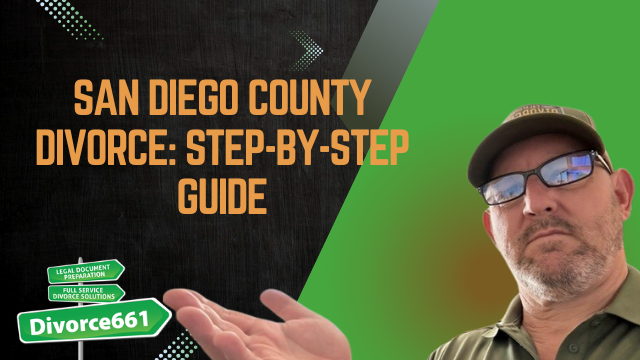San Diego County Divorce: Step-by-Step Guide
Hi — I’m Tim Blankenship with Divorce661. If you’re starting a divorce in San Diego County, the paperwork, e-filing rules, and court requirements can feel overwhelming. I created this step-by-step guide to walk you through the process so you can get your divorce done quickly, affordably, and without unnecessary trips to court.
Quick overview: the five essential steps
- File the Petition and local forms (electronically).
- Serve your spouse and file proof of service.
- Complete and exchange financial disclosures.
- Draft a Marital Settlement Agreement if you’re in agreement.
- Submit the judgment package to the court for approval.
Step 1 — File your Petition for Dissolution
Filing the Petition for Dissolution of Marriage officially opens your case. In San Diego County you must e-file your documents through an approved e-filing provider. That means your paperwork needs to be formatted correctly from the start to avoid rejection.
Don’t forget the summons and any required local forms. Missing or improperly formatted local forms are a common source of delays.
Step 2 — Serve your spouse
After filing, the next legal requirement is proper service. You cannot serve the papers yourself. Service must be done by:
- Someone over 18 who is not a party to the case, or
- A court-accepted alternative if your spouse is cooperative, such as a notice and acknowledgement of receipt.
Once service is completed, you must file a proof of service with the court. This step is critical because it triggers the mandatory 6-month waiting period before a divorce can be finalized in California.
Step 3 — Complete and exchange financial disclosures
California law requires both spouses to disclose their financial situation. That means providing full information about:
- Income and expenses
- Assets and property
- Debts and liabilities
These disclosures create the foundation for dividing property and determining support. In San Diego, incomplete or incorrect disclosures are one of the biggest reasons judgments get rejected. Make sure your disclosures are thorough, accurate, and exchanged in a timely manner.
Step 4 — Draft a Marital Settlement Agreement (if you agree)
If you and your spouse can reach terms, you’ll put those terms in a Marital Settlement Agreement. This document should clearly state:
- Who gets which assets and how debts are divided
- Whether spousal support will be paid and how much/duration
- Custody, visitation, and decision-making for minor children (if applicable)
- Any other obligations or agreements between the parties
The agreement must be complete and written in language the court accepts. An agreement that’s vague or misses required provisions can cause the final judgment to be rejected when submitted.
Step 5 — Submit the judgment package
When all procedural requirements are met — petition filed, proof of service on record, financial disclosures exchanged, and an agreement in place — you prepare the judgment package. This package typically includes your signed agreement, all required forms, and evidence that you completed each necessary step.
If everything is in order, San Diego County courts commonly review and approve uncontested judgment packages within about 2 to 4 weeks. That quick turnaround only happens when the package is complete and formatted correctly.
Common pitfalls to avoid
- Improper e-filing or incorrect document formatting — leads to rejections.
- Serving the spouse yourself — service must be handled by a neutral adult or an accepted alternative.
- Incomplete financial disclosures — a top reason for denied judgments.
- Vague settlement language — courts expect clear, enforceable terms.
- Missing local forms — San Diego County may require county-specific paperwork in addition to state forms.
Real client example
Recently, a San Diego couple tried to handle everything themselves and repeatedly ran into rejections. Their disclosures were incomplete, forms weren’t formatted to the court’s standards, and they didn’t know what the court required. Within one week of hiring Divorce661, we cleaned up their case, refiled the correct documents, and submitted the judgment package. The court approved it shortly after.
Checklist before you submit for judgment
- Petition and summons filed electronically through an approved provider
- Proof of service on file and 6-month waiting period noted
- All financial disclosures completed and exchanged
- Signed Marital Settlement Agreement that clearly resolves property, debts, support, and parenting issues (if any)
- All required local and court forms included and formatted correctly
Next steps and how I can help
If you want a fast, affordable, and stress-free path through an amicable divorce in San Diego County, I can help you handle everything: e-filing, service guidance, disclosures, drafting the settlement agreement, and submitting the judgment package. We offer flat-fee divorce services and fully remote support across San Diego County.
To get started, visit divorce661.com to schedule a free consultation. I’ll walk you through the entire process and make sure your paperwork is completed quickly and correctly.
Final thoughts
Divorce doesn’t have to be a months‑long administrative battle. With the right plan, attention to detail, and help when you need it, you can complete an uncontested San Diego County divorce efficiently and with minimal stress. Follow the five steps above, avoid the common pitfalls, and get the professional support you need to finish the job right.

